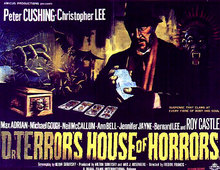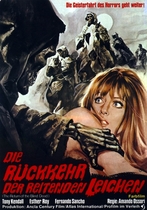Our editor-in-chief Nate Yapp is proud to have contributed to the new book Hidden Horror: A Celebration of 101 Underrated and Overlooked Fright Flicks, edited by Aaron Christensen. Another contributors include Anthony Timpone, B.J. Colangelo, Dave Alexander, Classic-Horror.com's own Robert C. Ring and John W. Bowen. Pick up a copy today from Amazon.com!
Dr. Terror's House of Horrors (1965)
Dr. Terror's House of Horrors was the first in a series of anthology films from the Amicus studio, and the one that launched them for a time to the same dizzying heights, at least at the box office, as their arch rival Hammer. But it is a film that prove Hitchcock's maxim about a film needing three things: a good script, a good script and a good script, as the poor quality of the writing is the factor that stops this from becoming a masterpiece.
Six strangers share a train carriage on a journey out of London. To pass the time, one gets out a deck of tarot cards and starts to tell the fortunes of his fellow passengers; however, all the stories end with the same card - Death...
Despite being often thought of as a British studio, Amicus was actually the brainchild of two Americans, Max J Rosenberg and Milton Subotsky, who brought their business to the UK to take advantage of the tax breaks and funding opportunities available in the 1960s, that had already attracted the likes of Stanley Kubrick and the producers of the James Bond films. Subotsky was a huge fan of horror films and was obsessed with getting his revenge on Hammer after they rejected his 1956 script Frankenstein and the Monster, only to have a huge hit a year later with The Curse of Frankenstein1. Unfortunately, his enthusiasm was not always matched by talent as a screenwriter, as is sometimes painfully obvious here. Director Freddie Francis has stated that he regularly had to rewrite the script as they were filming, as it often made no sense.2
Because the stories vary wildly in tone, content and quality, it's best to look at them individually.
"Werewolf"
Jim Dawson, an architect, returns to his former family home on a remote Scottish island to carry out some work for the new owner. However, a grisly find leads him to discover a curse on his ancestors - and something deadly in the cellar.
This episode provides a good start to the film thanks to two strong points. Firstly there is the gloomy Gothic atmosphere of cobwebs and countryside that kicks in as soon Dawson lands on the island, which contrasts well with the mostly urban and suburban settings of the other stories and help to give it a unique look and feel within the film. The impressive looking interiors belie the low budget, although this was mostly down to art director Bill Constable managing to use sets from other films that he found lying around Shepperton Studios. Secondly, realizing he hadn't got the time or money to go for the man-in-a-furry suit approach to the monster, Francis opted to use a dog, and only for four extremely brief (almost to the point of subliminal) shots, whose brevity makes them shocking and memorable. The writing is generally competent, keeping things moving along at a good pace, even if the end is rather predictable.
"Creeping Vine"
A family returns from vacation to find an odd-looking vine growing in the garden. The Triffid-like plant is not only intelligent, but also turns homicidal if threatened.
After an atmospheric start with the werewolf story, the film's tone now veers off into one of camp silliness. To their credit, everyone plays it pretty straight, especially non-actor Alan Freeman (a well known British TV and radio presenter), who is much less wooden than expected as the everyman head of the family. Bernard Lee, as the Government scientist trying to find the vine's origins, lends some much needed gravitas to lines like "a plant like that... could take over the world". The special effects consist of a plant on the end of a piece of wire, which although no worse than could be expected given the time and money available, completely derail any attempts at creating an atmosphere of terror. The writing is zippy although lines like the aforementioned one and "If a species ever develops that isn't (afraid of fire), it could be the end of the world" add to the silly tone. Again the script hampers things, with the main problem lying with the premise. I think menacing plant life can work well in literature (The Day of the Triffids) but every attempt I have seen to put that on the screen has ultimately failed, because shuffling corpses may look scary, shuffling vines do not.
"Voodoo"
Biff Bailey is a jazz musician working in the West Indies who steals a tune from a local voodoo ceremony. When he tries to use it back in London, sinister things start to happen.
This is where the film really hits rock bottom. The story is poorly paced, seeming to take forever to get going, with everything played in goofy comedy style that quickly becomes grating. Only in the last few minutes of the segment do things start to get tense, with Biff being stalked round London by a Voodoo priest. However, this soon splutters to a halt with the damp squib climax, where the priest breaks into Biff's apartment, takes the sheet music with the stolen song on it and walks off, while Biff faints (which does not seem to tie in with the fatal ending that Dr. Terror's cards predicted). The continual presentation of any black characters and their culture as threatening and mysterious is certainly cringe-worthy, although I did not detect any genuine malice behind it. It was more politically incorrect rather than out-and-out racist. The voodoo song is merely a "MacGuffin," something for the character to steal.
"Disembodied Hand"
Christopher Lee plays Franklyn Marsh, a pompous art critic consumed with rage after being publicly humiliated by Eric Landor (Michael Gough), an artist whose work he had been disparaging. Landor's constant hounding of him finally pushes Marsh over the edge and he runs down the artist, severing his right hand in the process. His nemesis might be gone, but a certain appendage just won't leave him alone.
This story is by far the highlight of the film, and I would go so far as to say that it is worth watching the film just for this segment. Although the story owes a great deal to The Beast with Five Fingers, it adds some original ideas, such as altering the plot to make it a duel between the two protagonists. As he did with the "Werewolf" segment, director Freddie Francis keeps the action moving along at a fairly rapid pace without sacrificing coherency. The star of the show is, of course, Christoper Lee, in a role that was something of a departure for him at that point in his career. Marsh is not just evil, but also highly obnoxious, and a pompous bore, devoid of any of the sinister charm of Dracula or Lord Summerisle. The other real star is the hand itself, which, according to Freddie Francis, was not a man hiding behind a chair waving his arm around, but a specially constructed mechanical effect3, which creeps around surprisingly convincingly.
"Vampire"
Dr. Bob Carroll (Donald Sutherland) returns to his home town with his new French wife Nicole, and finds a vampire is on the loose. Carroll enlists the help of his colleague, Dr. Blake, to track down the culprit, but their investigations start to lead him a little too close to home. Is the bloodsucker none other than his new bride?
After the excellent "Disembodied Hand" episode, it is a shame the film has to end with this clunker. The whole thing feels like it was made up as they went along (which might not be too far from the truth given Francis' comments regarding the script). This in turn leads to a baffling lapse in logic towards the end. Following Blake's advice, Carroll kills his wife, despite the fact that he has seen no evidence and only has Blake's word for it that she is the vampire. The twist ending regarding the real identity of the vampire is telegraphed way in advance and just comes across as glib and childish.
So, what could have been a great little anthology horror film in the tradition of Dead of Night (of which Subotsky was a huge fan) is spoiled by a poor and unimaginative script. The whole thing feels like a "greatest hits" of horror clichés, in as much as we get a werewolf, vampires, creeping vines and voodoo, without providing a fresh take on any of those themes. The stories were originally written as episodes for a television series that never got off the ground4, and the vampire story in particular which could possibly have worked well over about 25 minutes, slowly building up the menace and tension to the twist ending; played out over 10 minutes, it just feels rushed and illogical. This leads me to think the film would have worked better by dropping one of the weaker stories, such as "Voodoo," and slightly expanding one or more of the others.
It doesn't always hit the heights of the Hammer films it tries to compete with, but fans of Francis, Cushing and Lee will definitely want to see it once, and while Dr. Terror's House of Horrors is not exactly terrifying or horrifying, neither is it terrible or horrible either.
- 1.Hodgkinson, Will. "Blood and Gutsiness." The Guardian. 13 February 2009: F6.
- 2. Francis, Freddie and Jonathan Southcott. Audio Commentary. Dr. Terror's House of Horrors. DVD. Anchor Bay UK, 2006.
- 3. Ibid.
- 4. http://en.wikipedia.org/wiki/Dr._Terror's_House_of_Horrors
Trivia:
Just a few months after this was made, Roy Castle and Peter Cushing would team up again with Subotsky for the big screen adaptation of the BBC TV series "Dr Who and the Daleks"
The "Death" card always turns up at the end of each tale, signifying the person in the story was not going to survive. However, in Tarot, it is usually more associated with some sort of change or upheaval rather than the literal end of a life.









I bought the DVD for 99p -
I bought the DVD for 99p - worth every penny! The Christopher Lee section was far and away the best part of the film.
I enjoyed your review, and
I enjoyed your review, and agree with your assessment of the individual episodes with one exception.
I love the "Voodoo" segment. It's the campiness that makes this part so enjoyable. The songs in the nightclub add to the enjoyment. This movie, and this segment in particular, are what sixties "British" horror were all about!
Where can I get a copy of this DVD that can be watched on US DVD players?